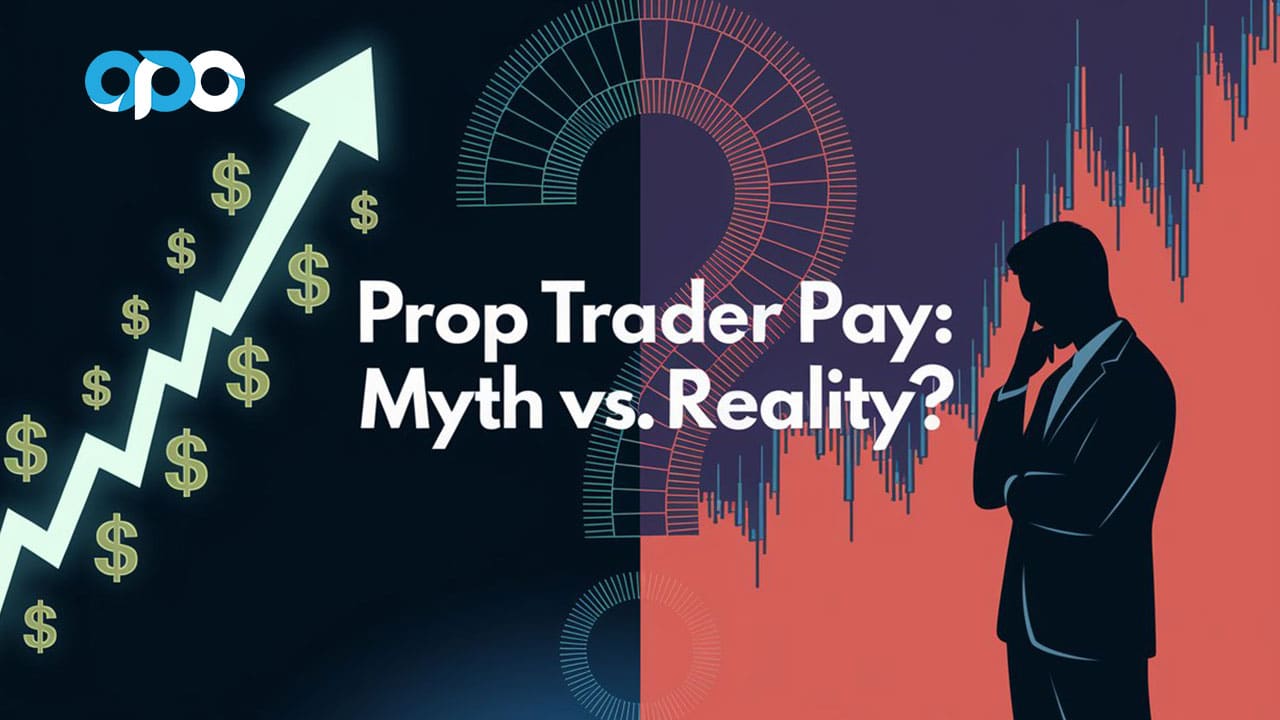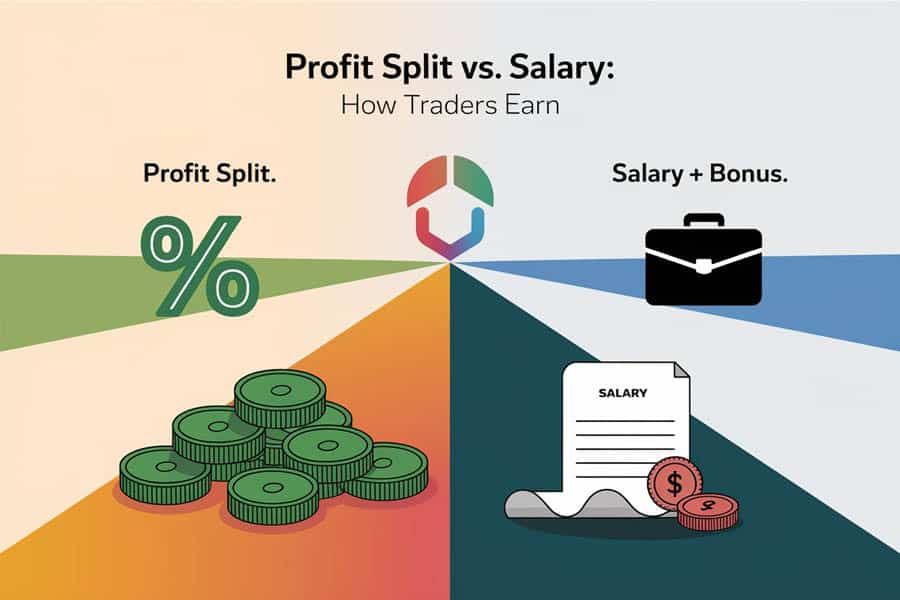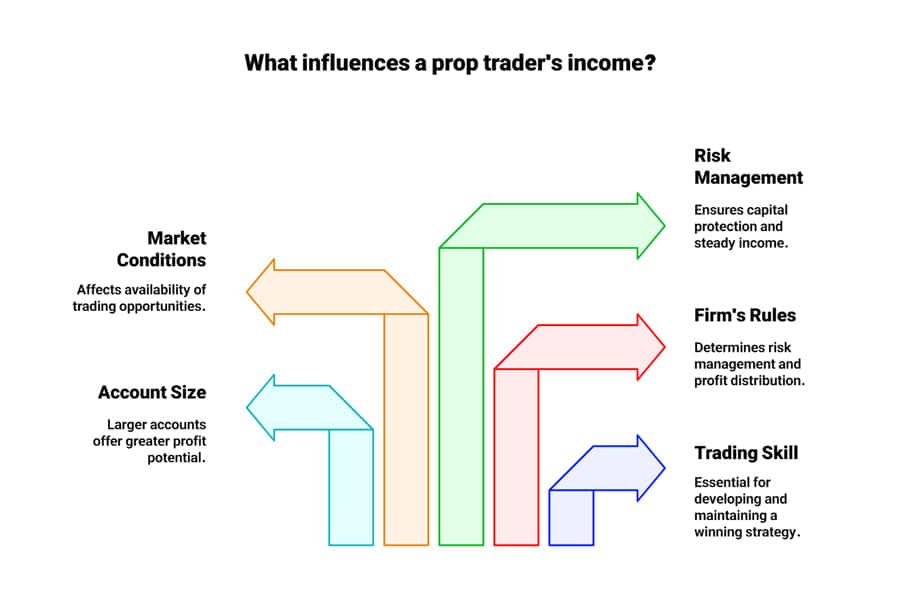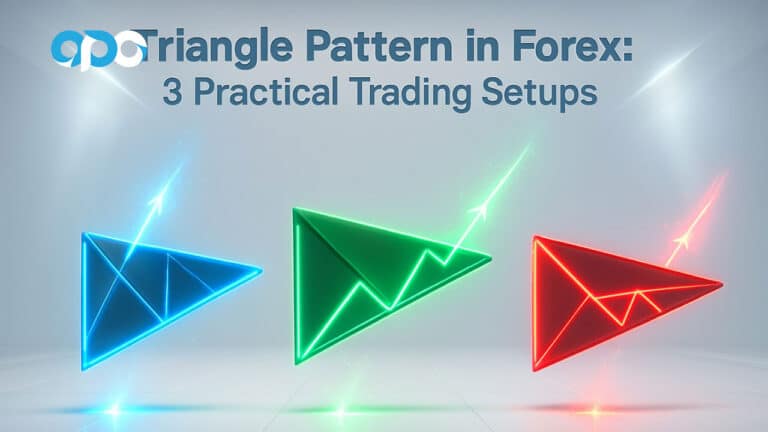Ever wondered about the world of proprietary trading and what traders actually earn? It’s easy to get drawn in by stories of massive payouts, but separating the hype from reality can be tough, leading to guesswork and maybe even setting yourself up for disappointment. So, what does it really take to make it, and what kind of income can you realistically aim for?

This article cuts through the noise to answer the core question: how much do prop firm traders make? We’ll break down how they get paid, what impacts their earnings, realistic income possibilities, the costs involved, and the real risks versus rewards. Whether you’re eyeing a traditional firm or checking out an online regulated forex broker with prop-style programs, getting a clear picture of the financial side is step one.
Getting a Grip on Prop Trading Earnings
Before we jump into salary figures and profit splits, let’s quickly cover what prop trading is and why understanding the potential income is so important if you’re considering this path.

What Exactly is a Prop Trading Firm?
Simply put, a proprietary (prop) trading firm is a company that trades financial markets – think stocks, currencies, commodities – using its own money, not money from clients. Their main game is to make profits for the firm itself through smart trading. The traders who work for or partner with these firms use the company’s cash and often its leverage to make trades, following either the firm’s strategies or their own approved methods.
Why Does Knowing Prop Trader Income Matter?
Getting a realistic handle on how much prop firm traders make is crucial for setting sensible expectations. The dream of big paychecks is appealing, but the day-to-day reality is often more complicated. Income in prop trading is rarely a sure thing; it almost always comes down to performance. Going in with unrealistic ideas can lead to frustration, financial stress (especially if you’re paying fees to get evaluated), and could even end your trading ambitions prematurely.
A clear view helps you figure out if the risk-reward balance fits your financial situation, how much risk you’re comfortable with, and frankly, if you have the skills needed. It helps you make smarter choices about whether this challenging, but potentially rewarding, career is right for you.
How Prop Firm Traders Get Paid: The Main Ways
The way prop traders earn money isn’t one-size-fits-all. It often depends on the type of firm. The two most common setups are the profit split, which you’ll see a lot with online/remote firms, and the salary plus bonus model, more typical in traditional, office-based firms.

The Profit Split Model: Sharing the Wins
This is the go-to model these days, especially with the boom in online or remote “funded trader” programs. It’s all about performance – your earnings are directly linked to how well you trade.
- How it Works: The firm gives you a chunk of its capital to trade with. You don’t get a regular salary. Instead, you keep a percentage of any profits you make using that capital. The firm takes the rest.
- Typical Profit Split Ratios: The splits usually favor the trader, often starting around 50/50 but commonly seen at 70/30, 80/20, or even 90/10 (that’s trader/firm). Some firms even offer scaling plans where if you consistently do well, your profit share percentage can go up, giving you more incentive to perform.
- Calculating Your Share (Example): It’s pretty straightforward. Let’s say you’re trading a $100,000 account and have a great month, making a 5% profit ($5,000). If your deal is an 80/20 split, you get 80% of that $5,000, which is $4,000. The firm keeps the other 20% ($1,000). This calculation directly impacts how much a prop firm trader makes each payout period.
The Salary + Bonus Model: Stability Plus Upside
You’re more likely to find this structure at established prop firms, often in big financial cities, where traders are regular employees working from an office. This offers more predictable income but might mean a smaller direct cut of the profits compared to just a profit split.
- How it Works: Traders get a regular base salary, which provides a safety net regardless of whether the market’s choppy or their performance dips slightly (though consistent losses are obviously a problem). On top of the salary, there are performance-based bonuses.
- Typical Base Salary Ranges: Base pay varies a lot based on where the firm is, its reputation, how experienced the trader is, and their specific job.
- Starting Out (Junior Trader): Online sources often point to starting salaries from $50,000 – $80,000, potentially up to $100,000 – $200,000 including bonuses at top US firms. In the UK, trainees might start between £30,000 – £50,000.
- Mid-Level Trader: After a few years and proving you can make money, base salaries can jump, possibly hitting $80,000 – $150,000+ in the US, or £60,000 – £120,000+ in the UK. With bonuses, total pay could be in the $200,000 – $500,000 zone at successful firms.
- Senior Trader/Manager: Top traders with amazing track records can pull in base salaries over $150,000 – $250,000. Bonuses can push total earnings way up, sometimes reaching $500,000 to over $1 million a year for the stars at elite firms. For context, Jane Street mentions base salaries of $250k-$300k for Quant Traders, noting this is just part of the total pay which includes a discretionary bonus.
- How Bonuses Work: Bonuses are usually tied to how much profit the trader (or their team) makes (P&L). It might be a set percentage of the profits or decided by management based on performance, risk management, and overall contribution. Often, the bonus is the biggest part of the paycheck, sometimes even doubling or tripling the base salary for top earners.
Key Difference: Online Funded vs. Employed Traders
It’s really important to know the difference here. Online funded traders usually work on a Profit Split. They’re typically independent contractors, not employees. They pay a fee for a chance to get funded and only earn from their profit share. They work remotely, using their own gear. Employed prop traders are on the company payroll, often work in an office, get a salary and benefits, plus bonuses. They don’t usually pay fees to trade the firm’s money. This difference is huge when asking “how much does a prop firm trader make?”, because the answer totally depends on which type of trader we’re talking about.
What Influences a Prop Trader’s Income?
Whether it’s a salary or profit split, several key things determine how much prop firm traders make. It’s not a fixed number; earnings swing based on personal skills, company rules, and what the market’s doing.

Trading Skill, Strategy & Consistency: The Big One
This is, without a doubt, the most important piece of the puzzle. A trader’s income potential rests on their ability to create, test, and stick to a winning trading strategy. This means reading the market, spotting good trades, executing them without getting emotional, and adjusting when things change. If your performance is all over the place, you let emotions drive your decisions, or your strategy just doesn’t work, your income will suffer, no matter how big your account is.
Account Size / How Much Capital You Trade
It stands to reason: trading a bigger account means bigger potential profits in dollar terms, even if the percentage gain is the same. A 5% gain on $50,000 is $2,500, but on $500,000, it’s $25,000. The potential payout (before the split) is ten times bigger just because the starting capital is larger. Many prop firms have scaling plans – if you trade well consistently, they give you more capital, directly increasing your earning ceiling. This factor significantly shapes how much prop firm traders make over time.
The Prop Firm’s Rules and Policies
Every firm plays by its own rules, and these rules directly affect how much you can earn.
- Profit Goals and Drawdown Limits: Evaluation stages (challenges) usually demand you hit certain profit goals without letting your account drop below strict loss limits (drawdown rules). Funded accounts have similar rules. Break a rule, and you typically lose the account, stopping your income from that source right there. These rules force you to manage risk carefully, which sometimes means you can’t chase every last bit of profit.
- Payout Schedules: Firms pay out profit splits on different timelines – maybe every two weeks, once a month, or maybe only when you hit a certain profit target. Knowing the schedule helps you manage your own money.
- Scaling Plans: As mentioned, these are pathways to trading more capital, often with better profit splits, if you hit performance targets. Understanding exactly what you need to do (like a certain % gain over time, or a number of successful payouts) is key to boosting your potential income.
Market Conditions and How Much They Swing
Trading opportunities aren’t always there; they come and go with the market’s mood. When markets are moving a lot (high volatility), skilled traders can find great chances to profit (though the risk is higher too). But when markets are flat or unpredictable, it can be tough to make money consistently, no matter how good you are. The specific markets you trade (like forex vs. stocks) also offer different kinds of opportunities.
Sticking to Risk Management
Beyond the firm’s hard rules on losses, managing your own risk discipline is essential. Traders who consistently keep risk in check – choosing the right trade size, using stop-losses, not trying to ‘win back’ losses emotionally – are much more likely to protect their capital and make money steadily over the long run. Wiping out an account because of bad risk management means zero income from that account.
The Firm’s Business Model (Especially Online)
It’s worth thinking about how the prop firm makes its money, particularly the online ones. Some seem to rely a lot on the fees from traders who fail the evaluation challenge. This might suggest they aren’t as focused on building up successful long-term traders. Others clearly make most of their money from sharing profits with consistently winning traders. Checking out a firm’s reputation, how reliably they pay out, and how many traders seem to succeed long-term can give you clues about their legitimacy and ultimately affect your chance of sustained earnings.
So, What’s a Realistic Income Range?
Trying to nail down a precise number for how much prop firm traders make is tough because it varies so much, especially with profit splits. But we can look at typical salary data for employed traders and explore potential scenarios for funded traders, always remembering that performance is king.
Average Paychecks (For Employed Traders)
Salary websites and industry chatter give us clues about pay for traders working directly for traditional prop firms (the Salary + Bonus types). Just remember these are averages – the actual numbers depend a lot on the firm, city, and how well the trader performs.
- Overall Averages: You might see average base salaries in the US mentioned around $100,000 – $125,000 a year, but this mixes everyone from newbies to veterans. Some sources suggest average total pay (including bonuses) hits $100,000 to $300,000. Big finance cities like New York usually pay more (averages $126k+).
- New vs. Experienced: Newbies might start with base pay around $50k-$80k, but total pay could reach $100k-$200k at top firms with bonuses. Mid-level folks might get $80k-$150k base, with total pay possibly reaching $200k-$500k. Senior pros can command $150k-$250k+ base, and total pay can shoot past $500k-$1M+ for the real stars. UK numbers show trainees starting around £30k-£50k, rising potentially to £120k+ base for experienced traders, plus significant bonuses.
Crucially, these numbers are for employed roles, which often require specific degrees, tough interviews, and working in an office.
Potential Earnings from Profit Splits
For remote/online funded traders on profit splits, income is 100% about performance, making it extremely variable. There’s no safety net salary.
- Doing the Math (Examples):
- Trader A has a $100k account, makes 5% ($5,000) in a month, and gets an 80% split. Monthly income: $4,000.
- Same Trader A makes 3% ($3,000) the next month. Income: $2,400.
- Trader B gets scaled up to $200k, makes 4% ($8,000), and gets a 90% split. Monthly income: $7,200.
- Trader C has a losing month or breaks a rule. Income: $0, and maybe loses the account.
- Wild Swings are Normal: These examples show the direct link: performance = pay. Earnings are never guaranteed. A trader might crush it one month and break even (or lose) the next. The real challenge is being profitable consistently. Some suggest successful traders might average $8,000 to $25,000 monthly, but this definitely isn’t the norm for everyone trying prop trading.
- Top Earners vs. The Average Trader: You hear stories of traders making high six figures, even seven figures a year, especially if they manage huge accounts ($1M+) and nail consistently high returns. But that’s like hearing about lottery winners – it happens, but it’s rare. Most people who try prop firm challenges don’t pass. Many who do pass find it hard to stay consistently profitable.
- Realistic Monthly Goals: Making consistent monthly gains is tough. Evaluation targets might be 8-10%, but keeping that up long-term is very difficult. Many agree that a realistic, sustainable target for a skilled trader might be 2-5% per month. Even hitting 5% consistently ($4,000/month on a $100k account with an 80% split) takes serious skill and discipline. Chasing higher returns (like 10%+) often means taking more risk and is harder to maintain.
So, when thinking about how much prop firm traders make on profit splits, focus on achievable, steady percentage gains multiplied by your account size and split, not just the headline-grabbing success stories. It provides a much clearer picture of how much does a prop firm trader make in a typical scenario.
The Costs and Things to Keep in Mind (Funded Traders)
While the profit-split route means you’re not risking your own savings on trades, getting started as a funded trader does have costs. You need to budget for these and understand the hurdles.
Evaluation or “Challenge” Fees
This is usually the main upfront cost. To get access to a firm’s funded account, most online prop firms make you pass a test or “challenge.” You pay a one-time fee (that you don’t get back if you fail) for a demo account. On this account, you have to prove you can hit profit targets while staying within strict risk rules (like maximum loss allowed) and sometimes within a time limit. Fees change based on the account size you’re aiming for – from under $100 for a small ($10k) account up to $1,000+ for bigger ones ($200k+). Some firms promise to refund this fee if you pass and get your first payout.
Possible Monthly Fees
Less common than the one-time challenge fee, but some firms use a subscription model. Instead of one big fee upfront, you pay a smaller fee every month to stay in the evaluation or keep access to the platform/funded account. You need to weigh up the long-term cost of this model.
Data or Platform Fees
Usually, for online prop firms, the cost of using the trading platform and standard market data is included. But sometimes, especially if you need special data (like for certain futures markets), the firm might charge you extra. Always ask about any potential ongoing fees before you sign up.
Heads Up: Many Don’t Pass the Challenge
It’s really important to know that most people who try these challenges fail. Estimates often suggest over 90% don’t make it through. Why? Sometimes the profit targets are tough, the drawdown rules are very strict, people crack under pressure, or their trading strategy just isn’t consistently profitable. For many online prop firms, these failed challenge fees are a major source of income. Be realistic about your odds and think of the fee as the cost of trying out, with no guarantee you’ll get funded. Understanding this reality is part of understanding how much prop firm traders make – many make nothing and lose the fee.
Getting Paid: How Payouts Work
If you are successful and making profits on a profit-split model, knowing how and when you get your share is key. Firms have specific rules about withdrawals.
How Often Do Payouts Happen?
Firms have set schedules for sending out profit shares. Common timing includes:
- Every Two Weeks (Bi-weekly): Payouts are processed fortnightly.
- Monthly: Payouts happen once a month.
- On Demand / When You Hit a Target: Some firms let you withdraw once you’ve made a certain amount of profit or after trading for a minimum number of days in a payout cycle.
Usually, you need to be in profit overall and not have broken any rules when the payout date arrives or when you request a withdrawal. The very first payout might also have special conditions, like needing to trade the funded account for a full month first.
Minimum Withdrawal Amounts
Lots of firms set a minimum profit amount you need to reach before you can take money out. This could be a flat amount (like $100) or a percentage of the account size. It just saves them the hassle of processing lots of tiny payments.
How You Receive the Money
Prop firms use different ways to send you your profit share. Common methods are:
- Bank Transfer (Wire/ACH): Money sent straight to your bank account.
- Crypto: Getting paid in Bitcoin (BTC), Ethereum (ETH), or stablecoins like USDT is becoming more popular.
- Third-Party Payment Services: Companies like Deel, Wise, or others specializing in paying remote workers are often used.
Check what methods the firm offers and if there are any fees (though good firms often cover these) before you start.
Weighing the Pros and Cons of Prop Trading Earnings
Chasing income through prop trading offers some tempting upsides but also comes with serious downsides. Thinking carefully about both is vital.
The Potential Upsides
- Access to Big Money: Prop firms let you trade with way more capital than most people have access to personally, which can magnify profits.
- Leverage Power: Firms often get better leverage rates, which can boost potential returns (but also losses).
- High Earning Potential: Especially with profit splits, traders who are consistently good can earn very high incomes tied directly to their results, potentially much more than typical jobs pay. Understanding how much a prop firm trader makes highlights this upside.
- Less Personal Risk (Mostly): With profit splits, if you lose money on a trade, the firm usually covers it. Your main financial risk is losing the challenge fee.
- Just Focus on Trading: You can put your energy into your strategies and trading without worrying about finding investors or dealing with clients.
- Learning Curve: The structure, rules, and feedback can help disciplined traders get better, faster.
The Significant Risks
- Losing Your Challenge Fee: Since most people fail the evaluation, the most common outcome is simply losing the fee you paid to try.
- Stress and Mental Game: Trading under strict rules (especially loss limits) and knowing your income depends entirely on your performance can be incredibly stressful. It takes a strong mindset.
- Income Isn’t Steady or Guaranteed: Profit splits mean your income can swing wildly. You might have great months and months where you earn nothing. This makes budgeting tough. There’s no sick pay or vacation pay.
- Breaking the Rules: One mistake – like hitting your daily loss limit or holding a trade over the weekend when you shouldn’t – can mean losing your account instantly and any profits you’d built up.
- Shady Firms: While there are many good prop firms, the online space has some bad actors. Firms might suddenly change rules, be slow to pay out, or even disappear. Doing your homework on the firm is crucial.
- Market Upsets: Even the best traders have losing streaks because the market does unexpected things.
Keeping these risks in mind is essential when thinking about how much prop firm traders make. The exciting potential needs to be balanced against the real chance of earning very little or losing your initial investment (the fees).
Opofinance Services Section
For traders looking for a solid platform to sharpen their skills, whether aiming for prop trading later or just managing personal funds better, the right broker for forex trading makes a difference. Opofinance, regulated by ASIC, provides a suite of tools designed for today’s traders:
- Top Trading Platforms: Trade on industry standards like MetaTrader 4 (MT4) and MetaTrader 5 (MT5), plus the advanced cTrader and user-friendly OpoTrade platform.
- Smart AI Tools: Get ahead with AI technology like the AI Market Analyzer for market insights, an AI Coach to help improve your trading habits, and AI Support when you need assistance.
- Community and Growth Features: Tap into social trading insights and explore programs aimed at trader development (check their site for current prop-related opportunities).
- Easy & Secure Money Movement: Enjoy safe ways to deposit and withdraw funds, including bank transfers, cards, and popular crypto options. Opofinance doesn’t charge fees on deposits or withdrawals.

Opofinance offers a secure, feature-packed environment aiming to give traders the resources they need to navigate the financial markets successfully.
Check out what Opofinance offers!
Conclusion: Can You Make Good Money Prop Trading?
So, back to the big question: how much do prop firm traders make? The honest answer is: it really depends. For a small group of highly skilled, disciplined, and consistent traders, yes, prop trading can be very lucrative. Whether getting a salary plus bonus or earning through profit splits, top performers can potentially make significantly more than in many other professions. But for most people, it’s a tough road.
Success pretty much boils down to having a real trading edge, managing risk like a hawk, and having the mental strength to handle the pressure. Income is tied to performance and is often unpredictable, especially with profit splits. It’s vital to have realistic expectations. Thinking of prop trading as a quick path to riches usually leads to disappointment and lost fees. It’s a demanding field best suited for dedicated traders who know they have a profitable strategy and fully understand the risks involved in determining how much prop firm traders make.
Key Takeaways
- Prop firms trade their own money, not clients’.
- Pay models: Profit Split (online firms, based purely on performance) or Salary + Bonus (traditional firms, offers base stability).
- Key factors influencing income: skill, consistency, capital size, firm rules, markets, and risk control. Crucial for determining how much prop firm traders make.
- Salaried jobs (traditional) offer base pay ($50k-$250k+ depending on level) plus potentially large bonuses.
- Profit split income varies hugely, based only on performance (often 70-90% of profits made). No guarantees. Realistic steady gains might be 2-5% monthly.
- Online funded traders pay ‘challenge fees’ to qualify, and most don’t pass.
- Big potential rewards (income, capital) come with big risks (lost fees, stress, no guaranteed pay).
- Success demands exceptional skill, discipline, and realistic expectations about potential earnings.
Do I have to pay taxes on earnings from prop firms?
Absolutely. Earnings from prop trading are generally considered taxable income. How it works exactly depends on your country and whether you’re an employee or contractor. Salaried traders usually get taxed like regular employees. Profit-split traders are often treated as independent contractors, meaning they get their gross earnings and are responsible for figuring out and paying their own income and self-employment taxes. It’s always best to talk to a tax professional who understands trading income.
Can I trade crypto at a prop firm?
It depends on the firm. Some traditional firms might have specialized crypto desks. Many online prop firms have historically focused on Forex, indices, and commodity CFDs. However, more and more are starting to offer crypto CFD trading. Also, many now offer payouts in crypto. Always check the specific list of tradable assets a firm offers before you join.
What happens if I break a rule, like the drawdown limit?
Breaking a major rule, especially the maximum loss limit (drawdown), typically means your evaluation or funded account gets shut down immediately. Any profits you had made on the account might be lost. Some firms let you pay a fee to ‘reset’ an evaluation try, while others make you buy a completely new challenge. If you break a rule on a live funded account, you usually lose access to it and would have to pass another evaluation to get funded again.







